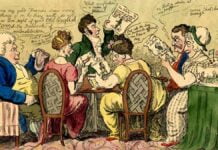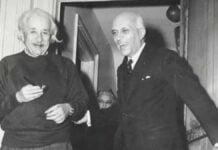Religio Medici, or The Religion of a Doctor, is a seminal work by Sir Thomas Browne, written in the 17th century. It is a reflective and philosophical text that explores Browne’s personal beliefs, experiences, and reflections on religion, science, and human nature. In its day, the book was a European best-seller and brought its author fame and respect throughout the continent. It was published in 1643 by the newly qualified physician after an unauthorised version of his writings on the Christian virtues of Faith, Hope and Charity had been distributed and reproduced with added text.
In his diaries, Samuel Pepys complained that the Religio was “cried up to the whole world for its wit and learning”, and its unorthodox views placed it swiftly upon the Papal Index Librorum Prohibitorum in 1645. Although predominantly concerned with the Christian faith, the Religio also meanders into digressions upon alchemy, hermetic philosophy, astrology, and physiognomy. Whilst discussing Biblical scripture, the learned doctor reveals a penchant for esoteric learning and confesses, for example, that “I have often admired the mystical way of Pythagoras and the secret magick of numbers.”
Browne’s latitudinarian Anglicanism allowed him to declare: “The severe schools shall never laugh me out of the philosophy of Hermes.” A rare surviving contemporary review by a distinguished member of the Parisian medical faculty, Gui De Patin (1601/2–72), indicates the considerable impact Religio Medici had upon the intelligentsia abroad:
”A new little volume has arrived from Holland entitled Religio Medici written by an Englishman and translated into Latin by some Dutchman. It is a strange and pleasant book but very delicate and wholly mystical; the author is not lacking in wit, and you will see in him quaint and delightful thoughts. There are hardly any books of this sort. If scholars were permitted to write freely, we would learn many novel things; never has there been a newspaper to this; in this way, the subtlety of the human spirit could be revealed”.
A translation of the Religio into German was made in 1746. In the early 19th century, Religio Medici was “re-discovered” by the English Romantics, firstly by Charles Lamb, who introduced it to Samuel Taylor Coleridge, who, after reading it, exclaimed, “O to write a character of this man!” Thomas de Quincey, in his Confessions of an English Opium-Eater, also praised it, stating:
”I do not recollect more than one thing said adequately on music in all literature. It is a passage in Religio Medici of Sir Browne, and though chiefly remarkable for its sublimity, also has a philosophical value since it points to the true theory of musical effects”.
In his writings in the 20th century, Swiss psychologist C G Jung used the term Religio Medici several times. Though little read nowadays, in Virginia Woolf’s opinion, Religio Medici paved the way for all future confessionals, private memoirs and personal writings. In the 17th century, it spawned numerous imitative titles, including John Dryden’s great poem, Religio Laici. Still, none matched the frank, intimate tone of the original in which the learned doctor invites the reader to share the labyrinthine mysteries and distinctive views of his personality.
It is far from clear that Thomas Browne ever considered publishing Religio Medici, his first and most influential work. Written during his medical apprenticeship in the mid-1630s, this essay on the religion of a doctor was circulated in multiple manuscripts among friends for seven years until 1642, when Andrew Crooke, an enterprising publisher of controversialist writing, obtained it and printed it anonymously, without the author’sauthor’s permission or knowledge. What Browne would later describe as “a private exercise directed to me” was an immediate commercial success, and Crooke quickly brought out a second edition. Browne, meanwhile, had wind of work about to be published by the colourful savant Sir Kenelm Digby, apparently responding to Browne’s essay. He immediately set about revising the pirated text for authorised publication in 1643. With Digby’s Observations upon Religio Medici, the 1643 edition, now with Browne’s name, established his reputation in English and Continental writing.
Religio Medici has been described as a spiritual autobiography, but it only occasionally resembles the true 17th-century form exponents like Lucy Hutchinson and John Aubrey. Although Browne’s subject is his own beliefs, the essay is better understood as a manifesto, a proclamation of tolerant Anglicanism in a period of repressive Laudian intervention and rising sectarian dissent. He uses his history of theological discovery and devotional meditation to propose a generous conception of religious practice and belief. This generosity was received with mixed enthusiasm in some quarters: the book was placed on the Vatican’s Index Expurgatorius in 1645, where it remained until the mid-20th century, while the most vocal English critics suspected Browne of Papistry and atheism; the Quakers, on the other hand, invited him to become a member of their church.
Exploration of Faith and Reason
Browne’s Religio Medici profoundly explores the relationship between faith and reason. A devout Christian and a man of science, Browne grapples with questions of theology and philosophy, seeking to reconcile his religious beliefs with his rational inquiry into the natural world. Through his introspective musings, Browne presents a nuanced perspective on the interplay between faith and reason, emphasising the importance of maintaining a balance between the two in one’s intellectual and spiritual journey.
Intellectual Depth and Complexity
Browne’s writing in Religio Medici is characterised by its intellectual depth and complexity. He delves into various topics, including theology, metaphysics, ethics, and cosmology, drawing upon a wealth of knowledge from classical and contemporary sources. Browne’s erudition is evident in his sophisticated language use and ability to engage with complex philosophical concepts, making Religio Medici a challenging yet rewarding read for scholars and intellectuals alike.
Humanism and Tolerance
Central to Browne’s philosophy in Religio Medici is his humanistic outlook and spirit of tolerance. Despite his unwavering commitment to his Christian faith, Browne adopts a liberal and inclusive approach to religious belief, recognising the diversity of human experience and the inherent dignity of every individual. He advocates for tolerance and mutual respect among people of different religious and philosophical persuasions, rejecting dogmatism and extremism in favour of open-minded inquiry and dialogue.
Prose Style and Literary Merit
Browne’s prose style in Religio Medici is marked by its eloquence, elegance, and richness of imagery. His writing is characterised by poetic sensibility and rhythmic cadence, inviting readers into a world of contemplation and introspection. Browne’s mastery of language and ability to evoke profound emotions and ideas through his prose contributes to the enduring literary merit of Religio Medici, cementing its status as a classic work of English literature.
Legacy and Influence
Religio Medici has significantly impacted subsequent generations of writers, thinkers, and theologians. Browne’s reflections on faith, reason, and the human condition resonate with readers today, inspiring countless interpretations and critical analyses. The work’s enduring relevance lies in its timeless exploration of universal themes and its profound insights into the complexities of the human experience.
Religio Medici is a masterpiece of philosophical and literary inquiry. It offers readers a thought-provoking exploration of faith, reason, and the search for meaning in the modern world. Browne’s introspective reflections, intellectual depth, and humanistic outlook make Religio Medici a timeless work that continues to captivate and inspire readers across generations.





























